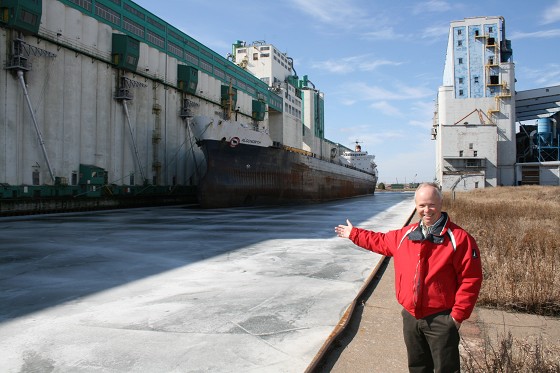Thunder Bay Port Authority CEO Looks For a Good Year With Project
Freight
by Scott A. Sumner
www.thunderbaybusiness.ca
Warm weather has resulted in good conditions for early ship travel at the Thunder Bay Port Authority this year but there are other factors as to when the shipping season will start. “The season in Thunder Bay is determined more by when they open the Welland Canal and the Sioux Locks both of which open on March 25th this year. We will have two ice breakers here on Friday and our ships will start to move after that.” said Tim Heney CEO Thunder Bay Port Authority. “Last year almost all of Lake Superior froze over but this year the only ice is in Thunder Bay. Right now it is 24 to 30 inches but that is fairly low. We will have a
ship in next week.” There are five ships currently at the port over the winter. They have 5 year inspections that have to be done and can be completed here in Thunder Bay with work on top and side repairs going on right now according to Heney. “We charge a fee for parking a ship. The Thunder Bay Port Authority doesn’t receive government funding so it is basically mandated to be self sufficient. We earn our revenue on harbour dues. In Thunder Bay, this amounts to about 7 cents a ton. These are the lowest fees on the lakes and we haven’t raised them since
1989,” said Heney. “We try to earn revenue from other sources like tenants in Keefer Terminal and lately we have generated funds with project freight like windmills. We also have storage revenue on oil sands equipment. A slow down in the oil sands has resulted in some equipment being stored here. These types of things help to sustain the Port.”

The Port has individual grain terminals that are privately owned. The only government owned part of the port is the Keefer terminal but the Heney’s organization recently purchased a 47 aces site with two grain terminal on it immediately adjacent to their operations. “We are
somewhat similar to the Thunder Bay Airport but they have ready traffic that is growing. The seaway has declined quite markedly, especially since the 80’s so the revenue is harder to come by. It was the worst year in the seaway history last year as they were down 28%. This was due to the fact that iron ore went into a tail spin. In Thunder Bay we lost a considerable amount of coal shipments. Grain was up 2 % and our general cargo was the best we have ever done. The coal drags us down overall about 10%.” said Heney.The peak year at the Thunder Bay Port Authority was 1983 when 18 million tons were moved. In 2009, the total was 7.2 million. “Thunder Bay used to move all of Canada’s grain exports and was the largest
grain port in the world. When the movement of the grain market went from Europe to Asia a lot of that became shipped to the west coast of Canada, a more natural route for these markets. There has also been more rail movement of grain, noted Heney. “The seaway is
viewed as an expensive route to move grain by the wheat board. The average ship is about 45 years old and we need fleet regeneration. We are trying to diversify to other shipments. The ships would be worth 50 million today- at least for a new one. Many of the ships are
reaching the end of their lives. There are some new ships being built in Asia. The ocean ships that are coming in are a lot newer but don't last as long because they are in salt water. The seaway is running at about 50% of capacity now. Our cargo freight can come on ships right
from Asia. Many of these ships are brand new and worth about $100 million because of their on board cranes etc.”
Last year the Port had 350 ships came here to Thunder Bay; while that number is usually in the 450 range, so there is the challenge? “We will continue with our project cargo. The grain is two parts. You move last year’s grain in the spring and then in the fall this year’s harvest. Grain has been fairly consistent. We hope to get some coal back but we have lost Stelco. The Ontario government is stopping coal use in their generating plants. There will be a smaller cruise ship
coming here again this year. Originally it was a private yacht given to a girl by her dad but she got tired of it and then was converted to a cruise ship. It is an exclusive ship for higher income clients. Overall the seaway is predicting it will be up about 10 %. Last year, it was down 28%.” said Heney. “We operate in the heavy industrial part of the economy and of course that hasn’t been good. I do see some opportunities in Thunder Bay though and believe that our traditional link to the west is very important. I think the west will rebound quicker than anywhere else. We have built some pretty important ties to the oil sands.
There is a lot of interest in the grain elevator we have just purchased,”says Heney. “If you look at Thunder Bay from afar there are opportunities here that people don’t see as yet. It is important to get out and push them. We can expand on our cargo freight. There are only
three ports in Canada that have two railway links right to the dock. The railways were built to Thunder Bay in the 1800’s. We have our own inter modal and track world class facilities. There is no reason we can’t put those to use. What Winnipeg dreams of is what we already have. We have infrastructure far surpassing what they could ever dream of because we have a water link
as well. Manitoba has always been important to us as well as Saskatchewan and Alberta.”
Tim Heney is a Chartered Accountant by training and graduated with a commerce degree from Lakehead University in 1977. His first job was at Great Lakes Paper and he has been at the Port Authority since 1991.









